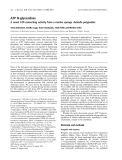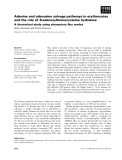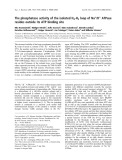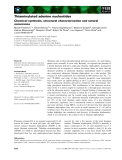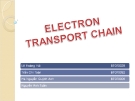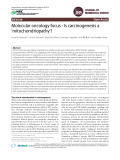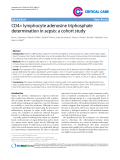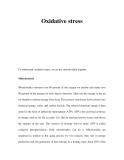
Adenosine triphosphate
-
HH là quá trình oxy hóa thức ăn kèm theo tổng hợp ATP xảy ra trong TB Kết quả các phân tử lipid, polysaccharid, acid béo & protein bị phân hủy ⇨ CO2, nước, ATP (Adenosin triphosphate) cần cho họat động sống của TB. Nguồn NL quan trọng nhất của TB là glucose. Mất nguyên tử hydrogen C6H12O6 + 6 O2 ⇨ 6CO2 + 6H2O + năng lượng Thêm nguyên tử hydrogen
 27p
27p  htc_12
htc_12
 16-05-2013
16-05-2013
 153
153
 12
12
 Download
Download
-
Bài giảng Hóa sinh đại cương - Chương 8 Trao đổi chất và năng lượng cung cấp cho người học những kiến thức như: Khái niệm trao đổi chất; Đồng hoá và dị hoá; Năng lượng tự do; Adenosine triphosphate (ATP); Quá trình vận chuyển điện tử; Cơ chế tổng hợp ATP. Mời các bạn cùng tham khảo!
 30p
30p  buctranhdo
buctranhdo
 02-07-2021
02-07-2021
 55
55
 10
10
 Download
Download
-
Bài giảng "Chương 8: Trao đổi chất và năng lượng" trình bày các nội dung: Trao đổi chất (Khái niệm, chức năng sinh học cơ bản của trao đổi chất, đồng hoá và dị hóa, ba giai đoạn của sự chuyển hóa trung gian), năng lượng sinh học (năng lượng tự do, Adenosine triphosphate, quá trình vận chuyển điện tử). Mời các bạn cùng tham khảo.
 15p
15p  nhansinhaoanh_03
nhansinhaoanh_03
 24-10-2015
24-10-2015
 149
149
 9
9
 Download
Download
-
Thuyết trình: Vai trò của ATP trong hoạt động của tế bào trình bày các kiến thức về Adenosine triphosphate (ATP), chức năng của ATP, sự hình thành của ATP và vai trò của ATP trong sự hoạt động của tế bào. Đây là tài liệu tham khảo cho bạn đọc nghiên cứu và học tập chuyên ngành Sinh học.
 28p
28p  beconbonmat91
beconbonmat91
 09-07-2014
09-07-2014
 457
457
 39
39
 Download
Download
-
Adenosine 5’-triphosphate (ATP) là hợp chất cao năng quan trọng nhất, giữ vai trò cung cấp năng lƣợng trong mọi tế bào sống. Bởi vì trong phân tử ATP có hai liên kết phosphate cao năng, năng lƣợng tự do sẽ đƣợc giải phóng khi ATP bị thủy phân thành Adenosine 5’-diphosphate (ADP) và một phosphate vô cơ (Pi), hoặc Adenosine monophosphate (AMP) và pyrophosphate (PPi). Do đó, phần lớn các hoạt động sống nhƣ vận chuyển, hấp thu dinh dƣỡng, sinh tổng hợp các chất, phân chia tế bào … đều sử dụng ATP nhƣ nguồn năng lƣợng trực...
 67p
67p  canhchuon_1
canhchuon_1
 19-06-2013
19-06-2013
 88
88
 11
11
 Download
Download
-
Conventional and saturation transfer electron paramagnetic resonance spectroscopy (EPR and ST EPR) was used to study the orientation of probe molecules in muscle fibers in different intermediate states of the ATP hydrolysis cycle. A separate procedure was used to obtain ST EPR spectra with precise phase settings even in the case of samples with low spectral intensity. Fibers prepared from rabbit psoas muscle were labeled with isothiocyanate spin labels at the reactive thiol sites of the catalytic domain of myosin....
 10p
10p  research12
research12
 01-06-2013
01-06-2013
 43
43
 6
6
 Download
Download
-
A novel nucleosidase enzymatic activity was discovered in the marine spongeAxinella polypoides. This enzyme, desig-nated as ATP N-glycosidase, converts adenosine-5¢-tri-phosphate into adenine and ribose-5-triphosphate. The crude extract ofA.polypoideswas capable of hydrolysing 25lmol ATPÆmin )1 per g wet weight of sponge. The cata-lytic activity of a sponge crude extract permg total protein is comparable with specific activities of purified plant adeno-sine and bacterial AMP nucleosidases.
 11p
11p  tumor12
tumor12
 20-04-2013
20-04-2013
 56
56
 3
3
 Download
Download
-
This article is devoted to the study of redundancy and yield of salvage pathways in human erythrocytes. These cells are not able to synthesize ATPde novo. However, the salvage (recycling) of certain nucleosides or bases to give nucleotide triphosphates is operative. As the salvage pathways use enzymes consuming ATP as well as enzymes producing ATP, it is not easy to see whether a net synthesis of ATP is possible. As for pathways using adenosine, a straightforward assumption is that these pathways start with adenosine kinase....
 13p
13p  fptmusic
fptmusic
 12-04-2013
12-04-2013
 47
47
 2
2
 Download
Download
-
The structural stability of the large cytoplasmic domain (H4 -H5loop) of mouse a1subunit of Na + /K + ATPase (L354– I777), the number and the location of its binding sites for 2¢-3¢-O-(trinitrophenyl) adenosine 5¢-triphosphate (TNP-ATP) andp-nitrophenylphosphate (pNPP) were investi-gated. C- and N-terminal shortening revealed that neither part of the phosphorylation (P)-domain are necessary for TNP-ATP binding.
 14p
14p  awards
awards
 05-04-2013
05-04-2013
 46
46
 5
5
 Download
Download
-
Thiamine and its three phosphorylated derivatives (mono-, di- and triphos-phate) occur naturally in most cells. Recently, we reported the presence of a fourth thiamine derivative, adenosine thiamine triphosphate, produced in Escherichia coliin response to carbon starvation.
 13p
13p  viettel02
viettel02
 22-02-2013
22-02-2013
 40
40
 3
3
 Download
Download
-
.Fuel of the Cell - ATP .Adenosine-5’-triphosphate C6H12O6 + 6O2 -- 6CO2 + 6H2O + Energy (ATP + heat) .ATP synthesis – Cellular Respiration .
 19p
19p  zingzing09
zingzing09
 21-10-2012
21-10-2012
 71
71
 5
5
 Download
Download
-
Abstract Mitochondria are sub-cellular organelles that produce adenosine triphosphate (ATP) through oxidative phosphorylation (OXPHOS). As suggested over 70 years ago by Otto Warburg and recently confirmed with molecular techniques, alterations in respiratory activity and in mitochondrial DNA (mtDNA) appear to be common features of malignant cells. Somatic mtDNA mutations have been reported in many types of cancer cells, and some reports document the prevalence of inherited mitochondrial DNA polymorphisms in cancer patients.
 7p
7p  toshiba23
toshiba23
 18-11-2011
18-11-2011
 59
59
 4
4
 Download
Download
-
Tuyển tập các báo cáo nghiên cứu về y học được đăng trên tạp chí y học quốc tế cung cấp cho các bạn kiến thức về ngành y đề tài: CD4+ lymphocyte adenosine triphosphate determination in sepsis: a cohort study...
 6p
6p  coxanh_6
coxanh_6
 30-10-2011
30-10-2011
 27
27
 2
2
 Download
Download
-
To understand oxidative stress, we review mitochondria together. MItochondria Mitochondria consume over 80 percent of the oxygen we breathe and make over 90 percent of the energy our cells need to function. They use the oxygen in the air we breathe to release energy from food. This process transforms food calories into chemical energy, water, and carbon dioxide. The released chemical energy is then stored in the form of adenosine triphosphate (ATP). ATP is the universal currency of energy used by all life on earth.
 4p
4p  truongthiuyen1
truongthiuyen1
 09-06-2011
09-06-2011
 68
68
 5
5
 Download
Download
-
ATP (Adenosine triphosphate) ATP là một nucleotide mà thực hiện nhiều vai trò thiết yếu trong tế bào.Đây là chính tiền tệ năng lượng của tế bào, cung cấp năng lượng cho hầu hết các hoạt động tiêu tốn năng lượng của tế bào. Đây là một trong các monome được sử dụng trong tổng hợp RNA và, sau khi chuyển đổi để deoxyATP (dATP), DNA .
 7p
7p  heoxinhkute13
heoxinhkute13
 26-04-2011
26-04-2011
 172
172
 29
29
 Download
Download
-
Adenine là một trong hai loại nucleobase thuộc nhóm purine là thành phần tạo nên các nucleotide trong các nucleic acid (DNA and RNA). TrongDNA, adenine (A) gắn với thymine (T) qua hai liên kết hiđrô qua đó giữ ổn định cấu trúc của DNA. Trong RNA, adenine đôi khi gắn với uracil (U), cũng qua hai liên kết hiđrô.
 5p
5p  heoxinhkute5
heoxinhkute5
 16-11-2010
16-11-2010
 246
246
 10
10
 Download
Download
-
ATP là phân tử mang năng lượng, có chức năng vận chuyển năng lượng đến các nơi cần thiết cho tế bào sử dụng. Chỉ có thông qua ATP, tế bào mới sử dụng được thế năng hóa học cất giấu trong cấu trúc phân tử hữu cơ.
 6p
6p  heoxinhkute
heoxinhkute
 27-07-2010
27-07-2010
 221
221
 39
39
 Download
Download
CHỦ ĐỀ BẠN MUỐN TÌM










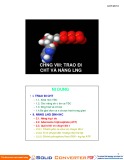

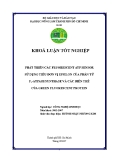
![Báo cáo Y học: Effect of adenosine 5¢-[b,c-imido]triphosphate on myosin head domain movements Saturation transfer EPR measurements without low-power phase setting Báo cáo Y học: Effect of adenosine 5¢-[b,c-imido]triphosphate on myosin head domain movements Saturation transfer EPR measurements without low-power phase setting](https://tailieu.vn/image/document/thumbnail/2013/20130601/research12/135x160/6961367834844.jpg)
